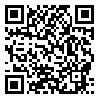دوره 9، شماره 1 - ( 11-1402 )
جلد 9 شماره 1 صفحات 131-116 |
برگشت به فهرست نسخه ها
Download citation:
BibTeX | RIS | EndNote | Medlars | ProCite | Reference Manager | RefWorks
Send citation to:



BibTeX | RIS | EndNote | Medlars | ProCite | Reference Manager | RefWorks
Send citation to:
Fattahi Ardakani M, Namiranian N, Afkhami Ardekani M, Zareipour M, Asadian A, Heydari S. Consumption of Medicinal Plants among Patients with Diabetes in Eastern Mediterranean Regional Office Countries: A Systematic
Review and Meta-Analysis. JNFS 2024; 9 (1) :116-131
URL: http://jnfs.ssu.ac.ir/article-1-797-fa.html
URL: http://jnfs.ssu.ac.ir/article-1-797-fa.html
Consumption of Medicinal Plants among Patients with Diabetes in Eastern Mediterranean Regional Office Countries: A Systematic
Review and Meta-Analysis. Journal of Nutrition and Food Security. 1402; 9 (1) :116-131
چکیده: (439 مشاهده)
Diabetes mellitus is a chronic disease which affects all aspects of human life. Medical herbs have become increasingly popular as complementary therapeutic measures for patients with diabetes. Thus, the present research aims to explore the consumption of medical herbs in patients with diabetes in Eastern Mediterranean Regional Office (EMRO) countries through a meta-analysis. Methods: The following keywords were searched: medicine, medicinal plants, healing plants, medicinal herbs, use, usage, frequency of use, prevalence, diabetes patients, type 2 diabetes, adults with diabetes, and EMRO countries. The databases searched included Scopus, PubMed, Web of Science, and Google Scholar. Results: A total of 3,542 papers were found. After omitting repeated or irrelevant papers, 70 papers were retained. An analysis of the abstract and full text of papers led to the retention of 35 papers. A great variance was found regarding the rate of consuming medical herbs in the papers (16.8-97.7%). The relative frequency of consuming medical herbs was 38% (95% CI: 33-44). Moreover, the most prevalent herbs were fenugreek (19%), cinnamon (18%), black seed (14%), white lupinus (13%), and olive (13%) with a 95% confidence interval. About 70% of patients (95%CI: 62-79) did not inform their physician of their herbal medicine consumption. Conclusion: In light of the present findings, it can be concluded that patients with diabetes use a wide range of medical herbs. Thus, health specialists and physicians need to be aware of the possible synergic or moderating effect of herbal medicine on the therapeutic measures taken for diabetes.
دریافت: 1401/10/5 | انتشار: 1402/12/2 | انتشار الکترونیک: 1402/12/2
| بازنشر اطلاعات | |
 |
این مقاله تحت شرایط Creative Commons Attribution-NonCommercial 4.0 International License قابل بازنشر است. |




